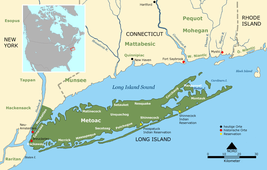Canarsee
The Canarsee (also Canarse and Canarsie) were a band of Munsee-speaking Lenape who inhabited the westernmost end of Long Island[3] at the time the Dutch settled New Amsterdam in the 1620s and 1630s.
As was common practice early in the days of European settlement of North America, a people came to be associated with a place, with its name displacing theirs among the settlers and those associated with them, such as explorers, mapmakers, trading company superiors who sponsored many of the early settlements, and officials in the settlers' mother country in Europe. This was the case of the "Canarsee" people,[lower-alpha 1] whose name, to the extent they identified with one, is lost in history.
It is the "Canarse" [sic], who only utilized the very southern end of Manhattan island, the Manhattoes, as a hunting ground, who are credited with selling Peter Minuit the entirety of the island for $24 in 1639.[5] A confusion of possession on the part of the Dutch which failed to realize that the balance of island was the hunting ground of the Wecquaesgeek, a Wappinger band of southwest Westchester County.[5]
The Canarsee were among the peoples who were conflated with other Long Island bands into a group called the Metoac, an aggregation which failed to recognize their linguistic differences and varying tribal affinities.[6]
Notes
- Alternative spellings include the above Canarsie and Canarse, was well as Canarise, Canarisse, and Canarsii.[4]
References
- Strong, John A. Algonquian Peoples of Long Island, Heart of the Lakes Publishing (March 1997). ISBN 978-1-55787-148-0
- Bragdon, Kathleen. The Columbia Guide to American Indians of the Northeast,Columbia University Press (2002). ISBN 978-0-231-11452-3
- Encyclopedia of New Jersey Indians: Encyclopedia of Native Peoples, Donald Ricky, 1998, p. 176
- Tribal Names of the Americas: Spelling Variants and Alternative Forms, Cross-Referenced, Patricia Roberts Clark, 2009, p. 41;
- "The $24 Swindle", Nathaniel Benchley, American Heritage, 1959, Vol 11, Issue 1
- Nathaniel Scudder, A History of Long Island From Its First Settlement By Europeans to the Year 1845, New York: 1845
